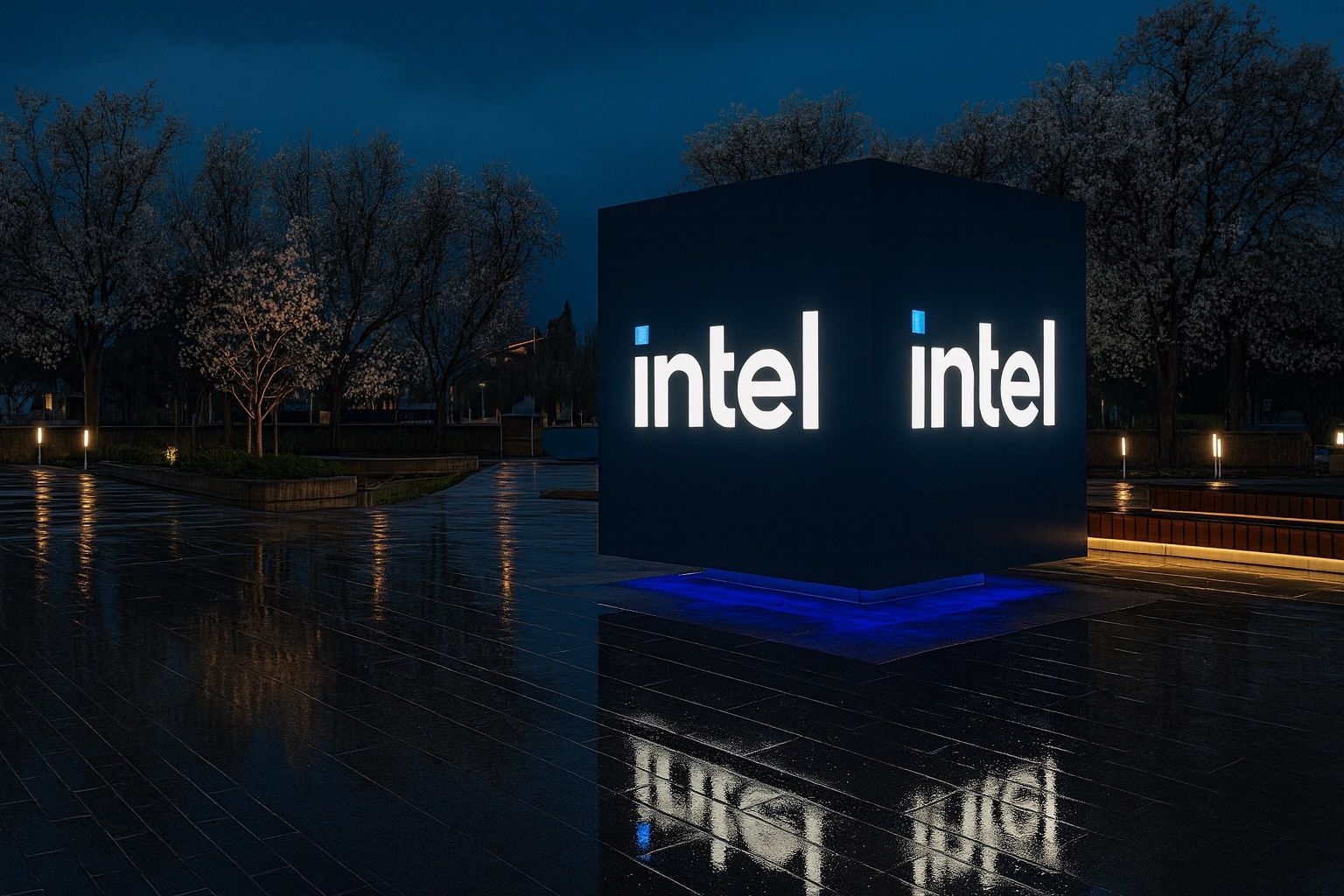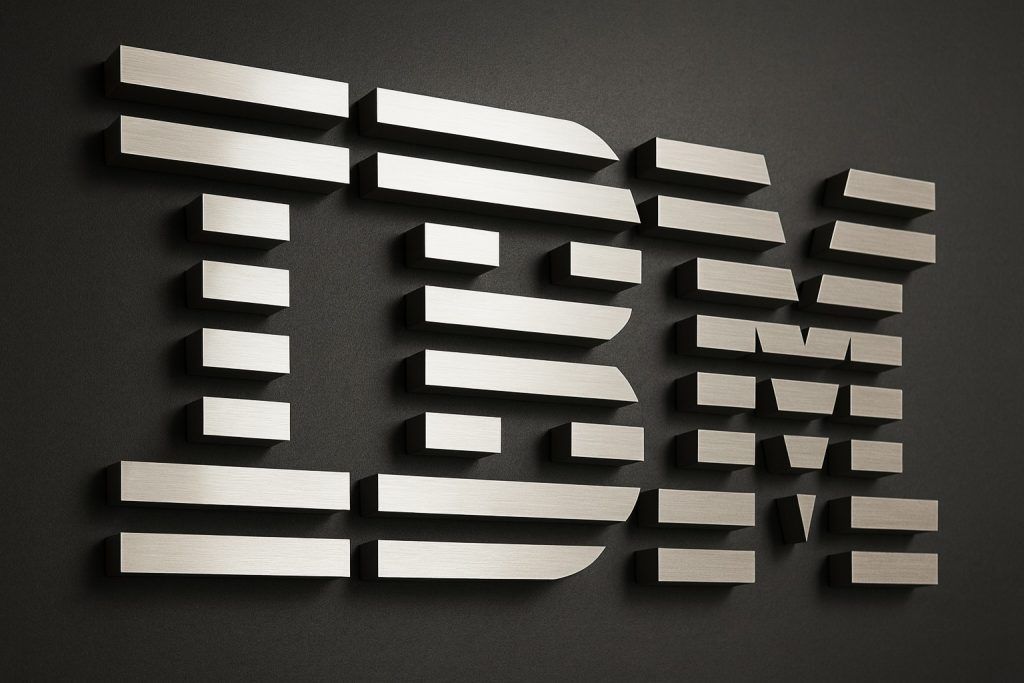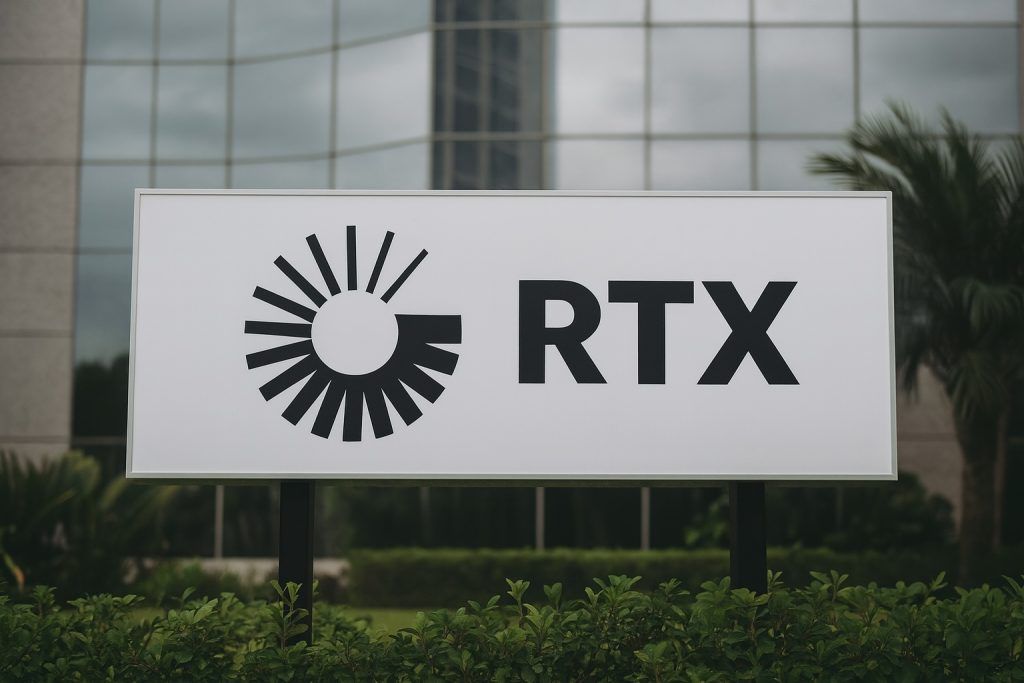- Mid-October surge: Intel’s stock is trading around the mid-$30s per share, near its highest level in over two years, after a volatile week that saw shares tick up about 0.7% on Friday, Oct. 17 [1]. The stock is up roughly 85% year-to-date [2], vastly outperforming the broader market, though it remains well below its 2021 peak [3].
- AI buzz and new deals: Investors are bidding up Intel on excitement over artificial intelligence. Reports this week suggest Intel’s foundry division secured a major AI chip client, speculated to be Microsoft for its Azure cloud, sending Intel shares modestly higher [4] [5]. Last month, Nvidia took a $5 billion stake (≈4%) in Intel as part of a partnership to co-develop PC and data-center chips [6] – a surprise vote of confidence from a top rival that sparked Intel’s biggest one-day jump since 1987 (a 22.8% gain on Sept. 18) [7].
- Big-name backers & geopolitics: In an unprecedented move, the U.S. government is acquiring a ~10% stake in Intel (via the CHIPS Act), investing ~$10 billion to bolster domestic chipmaking [8]. SoftBank poured in another $2 billion earlier this year [9]. Intel has even courted Apple – Bloomberg reported in late September that Intel approached Apple about an investment; while talks are preliminary, Intel’s stock jumped 6% on the rumor [10]. These infusions have lifted sentiment and share price, which has climbed ~40% since mid-August [11], but also raised geopolitical questions as foreign customers warily eye Washington’s influence [12].
- Financial turnaround questioned: Intel’s latest earnings showed flat revenue and ongoing losses. Q2 2025 sales were $12.9 billion (flat year-on-year), with gross margins under 30%, and the company remained unprofitable [13]. New CEO Lip-Bu Tan has slashed costs (cutting ~20% of staff) and refocused spending, but analysts don’t expect Intel to return to profitability until at least 2026 [14]. Q3 results are due soon, with the company guiding for a slight revenue uptick but deeper losses [15].
- Fierce competition: Intel’s rally comes as rivals thrive. Advanced Micro Devices (AMD) just hit all-time highs (~$240) after scoring blockbuster AI chip deals with OpenAI and Oracle [16], and some Wall Street bulls now predict AMD could reach $300 [17]. Nvidia still dominates the AI silicon market with an estimated 90% share of data-center GPUs [18], and its valuation (about 50× earnings) reflects sky-high growth expectations [19]. By contrast, Intel trades at a discount – its market cap (~$175 billion) is roughly half of AMD’s and just a fraction of Nvidia’s [20] [21] – but Intel is playing catch-up in the AI race. It recently announced a new data-center AI chip, “Crescent Island,” to launch in 2026 as a power-efficient GPU for AI inference [22] [23]. And on Oct. 9, Intel unveiled its upcoming “Panther Lake” PC processor architecture built on Intel’s cutting-edge 18A manufacturing process – though reports say yields for 18A chips are worryingly low, raising doubts about production and margins [24] [25].
- Mixed analyst outlook: Despite Intel’s rebound, most analysts remain cautious. The average 12-month price target is just ~$26 – implying almost 30% downside from current levels [26] – and the consensus rating is “Reduce” (only 2 buys vs 30+ hold/sell ratings) [27]. Skeptics argue that Intel’s stock already reflects a lot of good news and that the company still faces execution challenges (like fixing its manufacturing delays and catching up in AI) [28] [29]. Deutsche Bank, for example, reiterated a Hold with a $30 target even after the AMD-foundry rumors, which halted a brief rally [30]. At the same time, there are glimmers of optimism: Jim Cramer recently hailed Intel’s comeback under CEO Tan, calling him a “legendary semiconductor investor” after Tan secured the big government, Nvidia, and SoftBank deals that “sparked a roughly 50% rally” in the stock [31]. Ts² Tech, an analyst outlet, notes Intel’s leaner operations and strategic partnerships give it a fighting chance in AI, but emphasizes the company must prove it can execute and regain technological ground lost to TSMC, AMD and Nvidia [32].
Intel Stock Price: Recent Moves and Momentum
Intel’s share price has been on a roller-coaster in recent days, reflecting both excitement and caution. As of market close on Oct. 17, INTC traded in the high-$36 range [33], roughly flat for the week. The stock briefly spiked toward $38 earlier in the month – a new 52-week high – after reports that Intel was in talks to have AMD as a chip fabrication customer [34]. That October 2 report (via Semafor) sent Intel up almost 4% intraday [35], but gains faded when Deutsche Bank quickly warned the stock was overextended at those levels, urging investors to take profits [36].
Even with the recent volatility, Intel has been a standout performer in 2025. Shares have nearly doubled from their January lows, delivering about an 85% year-to-date gain [37]. The rally truly accelerated in late summer, as Intel started unveiling big strategic moves (and as the broader tech sector climbed on AI optimism – the Nasdaq has notched record highs recently [38]). However, it’s worth noting that long-term shareholders are still under water – Intel’s price remains well below its peaks from a few years ago [39], before the company’s slide began. The question now is whether the recent uptrend has room to run or if the stock is due for a breather. Many on Wall Street are debating if Intel’s newfound momentum is the start of a sustainable turnaround or a temporary AI-fueled sugar high.
Drivers: AI Hype, Foundry Deals and National Security
Several headline-grabbing developments have underpinned Intel’s comeback story this year. The biggest theme is AI – artificial intelligence – where Intel has long been seen as lagging, but is now scrambling to catch up. Just this week, a rumor hit markets that Intel’s foundry unit (which makes chips for outside clients) had finally secured a “major AI customer” for its forthcoming 18A process technology [40]. Tech insiders speculate that customer is Microsoft – potentially for Microsoft’s in-house “Maia” AI accelerators that power its Azure cloud, according to industry chatter [41]. Intel had previously announced Microsoft as a partner for 18A back in 2024, but concrete progress had been unclear. The new reports suggest Intel might actually produce advanced AI chips for Microsoft’s data centers, which would be a huge credibility boost for Intel’s foundry business if confirmed. The mere prospect of this deal gave Intel’s stock a modest lift on Friday [42], as investors dream of Intel becoming a viable player in the booming AI chip arena currently dominated by Nvidia and AMD.
Of course, the blockbuster partnership that truly put Intel back on traders’ radar was with Nvidia – the world’s leading AI chip maker. In mid-September, Nvidia agreed to invest $5 billion in Intel, acquiring roughly a 4% equity stake [43]. The deal, astonishing to many observers given the companies’ rivalry, is centered on co-developing new chips: Nvidia and Intel plan to collaborate on future PC and data-center processors that combine Intel’s CPUs with Nvidia’s GPUs [44]. Importantly, Nvidia clarified it’s not outsourcing its own GPU manufacturing to Intel (the partnership doesn’t touch Intel’s foundry services for now) [45], but the collaboration still symbolized a strong vote of confidence in Intel’s technology. For Nvidia, it secures influence at a key supplier and a hedge against reliance on TSMC; for Intel, it brings a seal of approval from the AI leader and potential design wins down the road. The stock market reacted in a frenzy – Intel shares soared 22.8% in a single day on the news, marking their biggest one-day gain since the 1987 stock market crash [46]. That dramatic pop illustrated how much optimism the Nvidia alliance injected into the Intel narrative.
On top of that, Intel has welcomed support from the U.S. government and other major investors as part of its turnaround plan. In late August, the Biden administration (under President Donald Trump in this scenario [47] – the timeline implies Trump’s second term) engineered a deal converting ~$10 billion of CHIPS Act subsidies into an equity stake in Intel. The government will effectively take a 9.9% ownership of the company [48], a highly unusual intervention aimed at propping up a “national champion” in advanced semiconductors. Intel’s CEO and board agreed to this move, seeing it as both a cash infusion and a strategic partnership – though it has raised concerns about political influence and potential foreign backlash [49]. Intel even warned in SEC filings that having Uncle Sam as a shareholder could deter some overseas customers or invite extra regulation [50]. Still, the market viewed the government stake as a bullish signal that Intel is “too important to fail.” It was quickly followed by $2 billion from SoftBank (via the tech-focused Vision Fund) in early September [51]. And then came the Nvidia stake. This trio of big backers – Washington, SoftBank, and Nvidia – gave Intel something it hadn’t had in years: momentum. By late September, Intel’s stock was on fire, prompting even Apple to reportedly show interest in getting involved. Bloomberg News broke word that Intel had approached Apple about a possible investment or foundry partnership [52]. The talks were very preliminary and might go nowhere, but just the idea of Apple’s support sent Intel shares up 6% on Sept. 24 [53]. Apple, of course, would have its own motives: it relies heavily on Taiwan’s TSMC to manufacture chips for iPhones and Macs, and any deepening of U.S.-based chip supply (via Intel’s fabs) could help hedge against geopolitical risk with China [54]. So even speculation of Apple teaming up with Intel added to the hype.
Not all the news has been positive, however. Intel’s newfound friends come with new scrutiny. The political dimension – essentially semi-nationalizing a chunk of Intel – has provoked debate in policy circles. Some overseas customers reportedly view a U.S. government stake as a red flag [55], fearing Intel could become an arm of U.S. industrial policy. And while Nvidia’s involvement is a confidence booster, it’s also an implicit acknowledgement that Intel can’t retake the lead alone. The same can be said of Intel’s overtures to once-unthinkable allies: partnering with AMD, its PC arch-rival, was another jaw-dropping storyline this month. The idea of AMD using Intel’s foundry services would have been laughable a few years ago, but on Oct. 1 a Reuters report (sourced from Semafor) said exactly that – Intel and AMD are in early talks about a foundry deal [56]. No details have emerged yet, and both companies declined comment on the rumor [57]. But the mere possibility that AMD, which has surpassed Intel in several markets, might pay Intel to manufacture some of its chips speaks volumes about both Intel’s new strategy (opening its fab doors to rivals) and the state of the industry (AMD looking to diversify production beyond TSMC, just as Apple is). This rumor contributed to Intel’s stock bump in early October, though as noted, caution from analysts tempered the rally.
Earnings and Fundamentals: Progress or Pipe Dream?
For all the excitement about AI and strategic partners, Intel’s financial fundamentals remain a work in progress. The company is still emerging from a severe slump: declining revenues, heavy losses, and painful cost-cutting have been the norm over the past two years. In its most recent quarter (Q2 2025), Intel generated $12.9 billion in revenue – basically flat compared to a year prior, but at least stopped the bleeding of consecutive declines [58]. It even beat Wall Street’s muted expectations on the top line. However, profitability is another story. Intel’s gross margin languished under 30% (far below historical levels ~55-60% in its heyday), and the company lost money for the quarter [59]. CEO Lip-Bu Tan, who took the helm at the start of 2025, has been in triage mode trying to right-size the ship. He has implemented massive cost reductions – cutting over 20% of Intel’s workforce and aiming to end 2025 with around 75,000 employees, down from ~100k+ not long ago [60]. Tan also put the brakes on expensive projects and expansion plans that don’t pay off immediately: Intel slowed construction of new chip fabs in Ohio, Germany, and Poland, despite political pressure, in order to conserve cash and focus on fixing its current production lines [61]. “No more blank checks,” Tan has declared, signaling a more disciplined approach to capital spending [62].
Those measures are starting to stabilize Intel’s finances, but real profitability is still elusive. Intel forecast that Q3 (the quarter spanning July–Sept 2025) would show a slight uptick in revenue as PC demand recovers a bit, yet also warned losses could deepen due to ongoing high R&D and the costs of under-utilized factories [63]. Many analysts doubt Intel can return to the black before 2026 [64]. The consensus is that Intel’s turnaround will be a long grind, not an overnight miracle. The company must execute on an ambitious roadmap – rolling out five new manufacturing process nodes in four years – and win back customers in chips where it has fallen behind (from mobile and GPUs to data center AI accelerators). There have been some encouraging signs: the PC market, a key revenue source for Intel, has shown hints of stabilizing after a long slump, and Intel’s latest PC processors have received decent reviews. But Intel’s data center CPU division still faces tough competition from AMD’s EPYC chips. Moreover, Intel’s nascent ventures into graphics processors and AI chips have yet to yield significant revenue.
A big overhang is whether Intel can successfully deploy its next-generation manufacturing technology, known as Intel 18A (the “Angstrom” era). This is the tech meant to restore Intel’s process leadership – or at least parity – with TSMC by 2025/2026. Intel’s upcoming client processors (code-named Panther Lake) are slated to use 18A, but according to an August Reuters exclusive report, yield rates on 18A are currently abysmal [65]. Only a small percentage of chips made on Intel’s trial runs have been coming out functional, sources told Reuters, raising the risk that Panther Lake’s launch could be delayed or unprofitable. Typically, a new chip process isn’t considered ready for prime time until yields are well above 50%. Intel’s CFO David Zinsner acknowledged in that report that 18A yields started off “low” though he expressed optimism they will improve by year-end [66]. If they don’t, Intel might be forced to ship chips made on 18A at a loss or very slim margins just to meet launch timelines [67] – not a reassuring scenario for investors. This yield issue is one reason some analysts remain skeptical of the hype: Intel has a track record of delays (its prior 10nm and 7nm nodes infamously slipped by years), and skeptics want to see proof that this time is different.
Competitive Landscape: Intel vs. AMD, Nvidia, and the World
Intel’s leaders and shareholders alike are well aware that the company is fighting uphill against fierce competition in the semiconductor industry. On one flank, there’s Nvidia, whose GPUs have become the irreplaceable engines of modern AI systems. Nvidia’s market capitalization recently crossed $1 trillion, roughly >5–6 times larger than Intel’s, and Nvidia is expected to haul in over $40 billion in data-center revenue this year alone – much of that from AI chips [68]. By contrast, Intel’s data-center and AI group has been shrinking; even including traditional server CPUs, Intel’s quarterly data-center revenue is under $5 billion. Nvidia’s advantage isn’t just market share – it’s also a rich software ecosystem (CUDA) and a two-year lead in hardware capabilities. While Intel hopes its new “Crescent Island” AI GPU in 2026 will start to narrow the gap, it will debut with some disadvantages (for instance, it uses slower memory than Nvidia’s flagship GPUs, per Intel’s disclosures) [69]. Nvidia’s investment in Intel suggests it sees Intel as useful, but not yet as an equal in AI technology.
On the other flank is AMD, which has executed one of the industry’s most remarkable turnarounds over the past decade. AMD’s stock is up ~80% in 2025 alone [70], roughly parallel to Intel’s rise, but for different reasons: AMD is gaining ground thanks to its own AI story. In early October, AMD revealed two mega-deals – one with OpenAI (to supply vast quantities of GPUs, with OpenAI taking an equity stake in AMD), and another with Oracle (to put tens of thousands of AMD accelerators in Oracle’s cloud) [71] [72]. These announcements caused euphoria around AMD; its shares surged ~30% in one day on the OpenAI deal [73]. Suddenly, analysts see AMD as a credible “No.2” alternative to Nvidia in AI. Multiple banks raised their AMD price targets to $300 or higher [74], implying further big gains. AMD’s CEO Lisa Su has boldly predicted that these partnerships could drive hundreds of billions in future revenue [75]. For Intel, AMD’s momentum is a double-edged sword: on one hand, if AMD’s Instinct MI series GPUs get wide adoption, it could squeeze Nvidia’s dominance and perhaps open more room for others (like Intel) in the market. On the other hand, AMD’s success underscores how far behind Intel currently is. AMD is now challenging Intel not just in CPUs (where it’s taken significant server market share) but even in the AI accelerator arena – an area where, a couple years ago, both lagged Nvidia badly. Now Intel finds itself in third place in a race that it wasn’t even in until recently.
There are also other contenders and shifting dynamics. Arm-based chips are rising in prominence; companies like Amazon, Google, and others are designing their own custom Arm server chips. A recent forecast from Arm Holdings projected that Arm-based processors could capture 50% of data-center CPU share by the end of 2025 [76] – a startling figure that speaks to the diversification away from x86 chips (Intel’s bread and butter) in cloud infrastructure. Intel’s response has been to position itself as an open platform that can work with everyone – its strategy of “mix and match” modular chips means customers could incorporate Intel CPUs alongside competitors’ accelerators, for instance [77] [78]. But it remains to be seen if that approach will win adopters. In manufacturing, TSMC remains the king: over 90% of the world’s most advanced chips are made in Taiwan [79]. Intel’s government-backed resurgence is partly aimed at changing that, by building up domestic fab capacity. Yet until Intel proves its technology equal to TSMC’s, most fabless chip designers (including AMD, Apple, and even Intel’s new ally Nvidia) will keep sending their most cutting-edge designs to TSMC. Geopolitical tensions (e.g., around China/Taiwan) could abruptly elevate Intel’s importance – something investors clearly have in mind with the government stake and Apple rumors – but that’s an unpredictable wildcard.
In terms of market value and valuation, Intel’s stock still looks comparatively cheap next to its rivals. Intel, even after the rally, has a market capitalization of around $175 billion and trades at a forward price/earnings ratio that is hard to calculate (since earnings are negative at the moment). AMD, by contrast, is valued around $300+ billion and trades at over 90× earnings [80] given its growth bets. Nvidia is worth roughly $1 trillion and fetches about 50× forward earnings [81]. Bulls argue this means Intel is undervalued if its turnaround succeeds – there’s plenty of upside if it can even partially close the gap. Bears retort that those low multiples are justified because Intel’s core business is mature or shrinking, and its high-growth bets are speculative. In fact, if you consider Intel’s loss-making status, its current price already bakes in a lot of expected improvement. The coming year or two will be critical for Intel to show investors tangible proof of progress: for example, securing that rumored Microsoft foundry contract, hitting its roadmap milestones (like actually launching Panther Lake on schedule and with decent yields), and ideally returning to profitability by 2026 as projected.
What Wall Street Is Saying
Given all these cross-currents, Wall Street analysts are divided – though more on the cautious side when it comes to Intel. According to MarketBeat data, the consensus rating is effectively “hold/slightly sell” [82]. Out of 32 analysts tracked, only 2 have a Buy on Intel, while 24 say Hold and 6 recommend Sell [83]. Price targets cluster in the mid-$20s; the average target is about $26, which is nearly 30% below the current stock price [84]. In other words, many analysts think the stock’s big run-up has overshot near-term reality. The most optimistic targets (high end around $43 [85]) assume Intel’s gambits in AI and foundry will pay off, but even that bull case is not much above the recent high of $38. On the bearish end, some analysts see potential downside into the teens (low target of $14 [86]) if Intel fails to deliver and the market loses patience.
Skeptics emphasize Intel’s execution risks and the intense competition. “[Intel] still has no profits and a history of delays,” notes TS² Tech, which while cautiously optimistic, echoes the view that Intel needs to prove it can close its technology gap [87]. Many want to see evidence that Intel’s ambitious roadmap (e.g. succeeding with 18A, 20A nodes on time) will actually happen. There’s also concern that Intel’s stock price is being propped up by external enthusiasm (government aid, hype around AI) more than by its own financial performance. If macroeconomic conditions turn or the AI hype cools, Intel could be vulnerable. As one market strategist warned regarding the AI-led rally in tech stocks, “any slowdown could be painful given how much growth is priced in” [88]. That comment, while about AMD/Nvidia valuations, applies similarly to Intel’s situation – a lot is riding on AI materializing as a revenue driver.
At the same time, supporters of Intel’s comeback argue that the company finally has the pieces in place to succeed. CNBC’s Jim Cramer has been particularly upbeat, calling CEO Lip-Bu Tan the man who could “save Intel” [89]. Cramer lauded Tan’s ability to attract massive investments (the U.S. government, Nvidia, etc.), saying those moves “sparked a roughly 50% rally” and signaled that Intel can matter again [90]. Some analysts have upgraded their stance in recent months: for instance, after the Apple investment rumors in late September, Seaport Research Partners upgraded Intel from Sell to Neutral, citing the potential strategic benefits if a deal with Apple or others comes through [91]. There’s a sense that if Intel can execute even moderately well – e.g. get Panther Lake out on time, start making chips for one or two big external customers, and stop bleeding cash – the stock could have further upside because it is still valued much lower than peers. And if Intel’s turnaround story really takes hold (with Washington’s backing and tech partnerships), some contrarians think sentiment could shift from pessimism to optimism more broadly.
For now, the dominant outlook from analysts is a careful balancing act: acknowledging Intel’s positive recent catalysts but maintaining a wait-and-see stance. “Near-term catalysts include the Panther Lake announcement on Oct. 9, progress on 18A yields, and any confirmation of deals with AMD or Apple,” TS² Tech wrote, adding that much of the good news may already be baked into the stock price [92]. In plain English: Intel has to keep delivering surprises to justify further stock gains. The company’s newfound momentum could either snowball – if it demonstrates real wins in AI and regained technical prowess – or it could stall out if results disappoint.
Bottom line: Intel’s stock has staged a remarkable rally in 2025 on the back of AI ambitions, heavyweight partnerships, and government support. This has reenergized the once-moribund chip giant and led to a burst of investor optimism not seen in years. Yet significant challenges remain for Intel to translate the hype into sustainable growth. The coming months will test whether Intel can truly reinvent itself in the age of AI – or whether the market has gotten ahead of reality. As Intel prepares for its next earnings report and product launches, shareholders should brace for more twists and turns. The only certainty is that Intel’s story, long a sleepy one, has suddenly become one of the tech sector’s most closely watched dramas. Investors will be watching each new development – from factory updates to AI chip benchmarks – to gauge whether this underdog rally can keep going, or if gravity will finally pull Intel back down to earth.
Sources: Recent analysis and data from TS² Tech [93] [94], Reuters [95] [96], CNBC/InsiderMonkey via TS² [97], Semafor/Reuters [98], Yahoo Finance [99], Investing.com [100] [101], and company filings.
References
1. ts2.tech, 2. ts2.tech, 3. ts2.tech, 4. ca.investing.com, 5. ca.investing.com, 6. www.reuters.com, 7. www.reuters.com, 8. www.reuters.com, 9. www.reuters.com, 10. www.reuters.com, 11. www.reuters.com, 12. ts2.tech, 13. ts2.tech, 14. ts2.tech, 15. ts2.tech, 16. ts2.tech, 17. ts2.tech, 18. ts2.tech, 19. ts2.tech, 20. ts2.tech, 21. ts2.tech, 22. www.reuters.com, 23. www.reuters.com, 24. www.reuters.com, 25. www.reuters.com, 26. ts2.tech, 27. ts2.tech, 28. ts2.tech, 29. ts2.tech, 30. ts2.tech, 31. ts2.tech, 32. ts2.tech, 33. ts2.tech, 34. ts2.tech, 35. ts2.tech, 36. ts2.tech, 37. ts2.tech, 38. ts2.tech, 39. ts2.tech, 40. ca.investing.com, 41. ca.investing.com, 42. ca.investing.com, 43. www.reuters.com, 44. www.reuters.com, 45. www.reuters.com, 46. www.reuters.com, 47. ts2.tech, 48. www.reuters.com, 49. ts2.tech, 50. ts2.tech, 51. www.reuters.com, 52. www.reuters.com, 53. www.reuters.com, 54. www.reuters.com, 55. ts2.tech, 56. www.reuters.com, 57. www.reuters.com, 58. ts2.tech, 59. ts2.tech, 60. ts2.tech, 61. ts2.tech, 62. ts2.tech, 63. ts2.tech, 64. ts2.tech, 65. www.reuters.com, 66. www.reuters.com, 67. www.reuters.com, 68. ts2.tech, 69. www.reuters.com, 70. ts2.tech, 71. ts2.tech, 72. ts2.tech, 73. ts2.tech, 74. ts2.tech, 75. ts2.tech, 76. ts2.tech, 77. www.reuters.com, 78. www.reuters.com, 79. ts2.tech, 80. ts2.tech, 81. ts2.tech, 82. ts2.tech, 83. ts2.tech, 84. ts2.tech, 85. ts2.tech, 86. ts2.tech, 87. ts2.tech, 88. ts2.tech, 89. ts2.tech, 90. ts2.tech, 91. ts2.tech, 92. ts2.tech, 93. ts2.tech, 94. ts2.tech, 95. www.reuters.com, 96. www.reuters.com, 97. ts2.tech, 98. www.reuters.com, 99. ts2.tech, 100. ca.investing.com, 101. ca.investing.com







